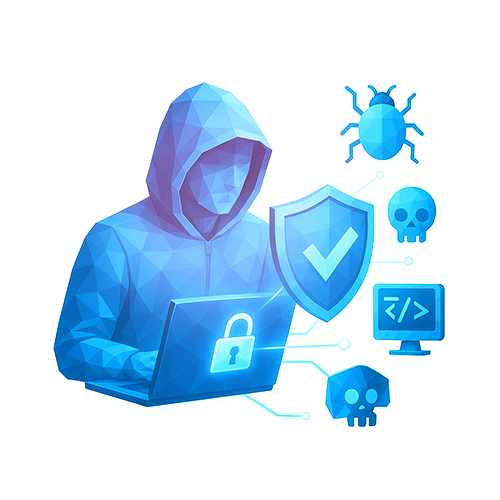
Why Ethical Hackers Are the Unsung Heroes of Cybersecurity

In May 2017, the WannaCry ransomware cryptoworm unleashed a global cyberattack against Microsoft Windows machines, encrypting files and demanding payment in Bitcoin. Its rapid spread hinged on EternalBlue, an NSA-developed Windows exploit that the Shadow Brokers leaked about a month earlier. Although Microsoft had already issued patches, many organizations either hadn’t applied them or were still running end-of-life Windows versions; teams cited round-the-clock uptime needs, fear of breaking working apps, and limited staff or time as reasons for delaying critical updates.
Researcher Marcus Hutchins identified a hardcoded “kill switch” domain; registering it as a DNS sinkhole prevented the malware from continuing to self-propagate, slowing the outbreak (though it didn’t decrypt already infected systems) and buying responders time, particularly across North America and Asia. On 14 May, a new build surfaced with a second kill switch that Matt Suiche registered the same day; on 15 May, another variant appeared with a third and last kill switch that Check Point analysts registered. Within days, a version with no kill switch at all was detected. By 19 May, attackers were reportedly trying to DDoS the kill-switch domain using a Mirai botnet variant, on 22 May Hutchins mitigated that risk by shifting to a cached setup capable of absorbing far more traffic. In parallel, researchers at University College London and Boston University showed that their PayBreak approach could recover the keys used by several ransomware families, including WannaCry.
Investigators also found that the Windows encryption APIs leveraged by WannaCry didn’t always fully clear the prime numbers used to derive the payload’s private keys from memory; if the process was still running and the machine hadn’t been rebooted, those values could sometimes be retrieved. A French researcher turned that insight into WannaKey for Windows XP, later extended as Wanakiwi for Windows 7 and Server 2008 R2. Thanks to these combined efforts, new infections dwindled to a trickle within four days of the initial surge, an outcome that underscores why ethical hacking, responsible disclosure, and proactive security research are indispensable for staying ahead of fast-moving threats.
What is Ethical Hacking?
Ethical hacking is the practice of inviting an external specialist to break into a company’s network in the same manner a criminal would, with one crucial difference: the organization grants permission. Within that scope, the hacker chooses their own avenues of attack and targets to mirror real-world conditions as closely as possible. People sometimes use the term interchangeably with penetration testing, but they aren’t identical. Pen tests typically follow a narrow brief say, evaluate a specific application or subnet and report on the defenses, whereas an ethical hacker’s mandate is broader and less constrained, making the exercise a truer measure of how a determined adversary might behave. (Learn more: 9 Penetration Testing Tools The Pros Use.) Given that wider remit, ethical hackers combine any tactic at their disposal to slip past controls, which is precisely what gives organizations a realistic read on their exposure.
Types of Ethical Hacking
In security circles, hackers are often grouped by “hat color,” a nod to old Westerns that distinguished heroes and villains by their attire.
- White hats are skilled practitioners who aim to help, not harm; they seek out weaknesses, disclose them responsibly, and usually operate under contract and explicit authorization, so their work is lawful.
- Black hats pursue intrusion for personal gain or malice, stealing card numbers, monetizing data, or otherwise exploiting access, and they’re the adversaries defenders must stop.
- Between those poles are gray hats, who may be driven by curiosity or challenge rather than profit; while they don’t necessarily intend damage, they act without permission, which makes their activities illegal. Some will submit findings through bug bounty programs, while others may flirt with black hat territory or publish issues if they feel ignored.
- You’ll also hear about blue hats, a label that can refer to skilled testers companies bring in to run penetration exercises; confusingly, in some communities the same term can also describe malicious actors bent on revenge.
Green hats, meanwhile, are newcomers sharpening their craft, motivated by learning and growth rather than profit or destruction with aspirations to become seasoned professionals in cybersecurity.
How does ethical hacking work?
Most ethical hackers work independently or on contract and carry credentials that signal competence, such as EC-Council’s Certified Ethical Hacker. Because they stand outside the organization they assess, they aren’t burdened by internal assumptions about what’s strong or weak. That distance helps them view the entire defensive posture objectively and spot gaps that insiders may overlook. Once engaged, they follow a familiar arc, beginning with reconnaissance to map out assets and potential weak points, then escalating to hands-on attacks to validate what they’ve found.
To do this, they draw on a toolkit that spans several domains. In web application hacking, they probe for classic flaws, SQL injection, cross-site scripting, cross-site request forgery, that can pivot a small coding mistake into serious access. Wireless attacks look for soft spots in Wi-Fi and related networks, a growing issue as mobile devices and remote work expand the attack surface. Social engineering targets the human layer, where phishing emails, voice scams, or even tailgating past a badge-controlled door can open the path to sensitive systems. System hacking aims straight at core business infrastructure by stealing or cracking passwords, abusing misconfigurations, or chaining minor issues into meaningful compromise.
Key ethical hacking techniques
The value proposition is straightforward: ethical hackers use the same playbook as criminals to gain a foothold, but they don’t steal anything and they hand back a roadmap for fixing what they exploited. Some companies retain them directly; others tap into bug bounty platforms that reward independent researchers for responsibly reporting vulnerabilities. The biggest advantage is realism. Black hat attackers constantly invent new twists and break patterns defenders expect; fresh eyes from outside can invalidate comfortable assumptions about how a breach might unfold. Builders and operators are often too close to the systems they’ve created, which makes blind spots inevitable. An attacker’s perspective reframes the landscape and reveals exposures that seem obvious in hindsight but hide in plain sight during day-to-day operations.
Common Weaknesses Exposed
Common weaknesses surface again and again:
Services left with insecure defaults or poor configuration.
Fragile or broken authentication flows.
Inadequate input validation that opens the door to injection attacks.
Social engineering weaknesses, where a persuasive message can coax credentials out of an otherwise well-protected environment.
Ethical hackers document these findings, explain their impact, and prioritize remediation so teams can close gaps before a real intruder takes advantage, often preventing the reputational damage, regulatory fallout, and financial loss that follow a breach.
Ethical Hacking vs. Penetration Testing
Ethical hacking is the practice of inviting an external specialist to try to breach your environment exactly as a criminal would, only with permission and guardrails, so you can see how your defenses hold up in the wild. It’s often conflated with penetration testing, but pen tests usually follow a narrow brief focused on a specific system or scope, whereas an ethical hacker operates with a broader, more free-form mandate that mirrors a real attacker’s creativity and persistence.
In practice, that wider remit surfaces issues your internal teams may never anticipate:
Web application flaws like SQL injection, XSS, and CSRF.
Wireless weaknesses that expand with remote work.
Human-layer gaps exploited through phishing or tailgating.
Direct system intrusions via weak authentication, poor configurations, or chained low-severity bugs.
The value is realism, ethical hackers use adversarial tactics without stealing data, then hand back a clear path to remediation so you can fix weaknesses before a black hat finds them. Builders are often too close to their own systems; outside eyes cut through assumptions, reveal blind spots, and turn vague risk into concrete, fixable work.
How Techverx Helps
If you want this rigor without the chaos, Techverx can help with end-to-end cybersecurity services tailored to your stack and risk profile. We run customized compliance examinations to align controls with your regulatory landscape, perform IT risk assessments to quantify business impact, execute both external and internal penetration testing to validate real-world exploitability, and keep you covered with ongoing internal and external monthly vulnerability scanning that feeds actionable remediation. We also add quarterly automated penetration testing to catch regressions and newly exposed attack paths fast, and we don’t stop at findings; we partner with your team to prioritize and finish remediation so those vulnerabilities are actually closed.
Ready to see what an attacker would see, and fix it before they try?
Discover your blind spots before attackers do. Get in touch with Techverx today for a tailored security assessment and start closing gaps before they turn into breaches.

Rachel Kent
Rachel Kent is a Technology Advisor at Techverx based in McKinney, Texas, specializing in digital strategy, scalable architectures, and “right-fit” solutions. With a background as a Software Engineering Lead and full-stack engineer across healthcare and tech, she bridges business goals with modern stacks to rescue stalled projects, modernize legacy systems, and deliver ROI-focused outcomes.
Hiring engineers?
Reduce hiring costs by up to 70% and shorten your recruitment cycle from 40–50 days with Techverx’s team augmentation services.
Related blogs


